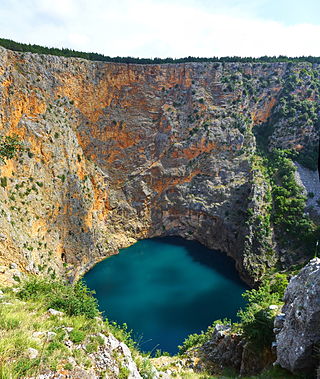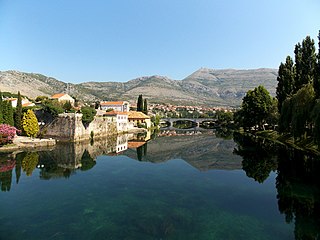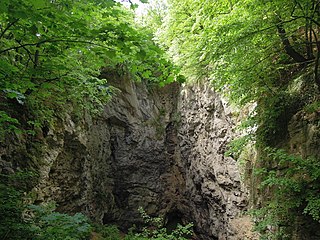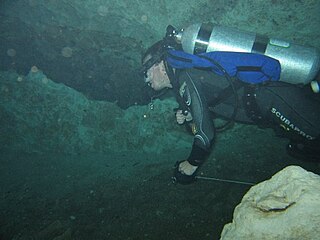
A cave or cavern is a natural void under the Earth's surface. Caves often form by the weathering of rock and often extend deep underground. Exogene caves are smaller openings that extend a relatively short distance underground. Caves which extend further underground than the opening is wide are called endogene caves.

Karst is a topography formed from the dissolution of soluble carbonate rocks such as limestone and dolomite. It is characterized by features like poljes above and drainage systems with sinkholes and caves underground. There is some evidence that karst may occur in more weathering-resistant rocks such as quartzite given the right conditions.

A sinkhole is a depression or hole in the ground caused by some form of collapse of the surface layer. The term is sometimes used to refer to doline, enclosed depressions that are also known as shakeholes, and to openings where surface water enters into underground passages known as ponor, swallow hole or swallet. A cenote is a type of sinkhole that exposes groundwater underneath. Sink, and stream sink are more general terms for sites that drain surface water, possibly by infiltration into sediment or crumbled rock.

A subterranean river is a river or watercourse that runs wholly or partly beneath the ground, one where the riverbed does not represent the surface of the Earth. It is distinct from an aquifer, which may flow like a river but is contained within a permeable layer of rock or other unconsolidated materials. A river flowing below ground level in an open gorge is not classed as subterranean.
Krubera Cave is the second-deepest-known cave on Earth, after the Veryovkina Cave. It is located in the Arabika Massif of the Gagra Range of the Western Caucasus, in the Gagra District of Abkhazia, a partly recognised state, previously part of Soviet Georgia.

A cenote is a natural pit, or sinkhole, resulting when a collapse of limestone bedrock exposes groundwater. The term originated on the Yucatán Peninsula of Mexico, where the ancient Maya commonly used cenotes for water supplies, and occasionally for sacrificial offerings. The name derives from a word used by the lowland Yucatec Maya—tsʼonoʼot—to refer to any location with accessible groundwater.
Raggejavreraige or Råggejávrrerájgge is a cave located in a mountain above the Hellemofjorden in Hamarøy Municipality in Nordland county, Norway. The cave is located near the lake Råggejávrre, about 2 kilometres (1.2 mi) south of the village of Musken. Råggejávrrerájgge is a limestone cave that has been eroded by this underground river. At 580 metres (1,900 ft) deep, it is the deepest cave in Scandinavia and the only known deep cave north of the Arctic Circle.

The Trebišnjica is a river in Bosnia and Herzegovina, and the right tributary of the Neretva. Before it was utilized for hydro exploitation via various hydrotechnical interventions and systems with different purposes, Trebišnjica used to be a sinking river, rising and sinking through its course before resurfacing at various places from the Neretva river below the Čapljina to the Adriatic coast, and along the coast from the Neretva Delta to Sutorina.

Blue Lake is a karst lake located near Imotski in southern Croatia. Like the nearby Red Lake, it lies in a deep sinkhole possibly formed by the collapse of an enormous cave. The total depth from the upper rim is around 220 metres (720 ft), while water depth varies with season. In spring, when the snow from surrounding mountains melts, it can reach 90 m (300 ft), and in 1914 it reached 114 m (374 ft), overflowing the southern rim. The lake is a popular destination for hiking and sight-seeing.

Škocjan Caves is a cave system located in Slovenia. Škocjan Caves was included on UNESCO’s list of natural and cultural World Heritage Sites in 1986. Škocjan Caves is a significant underground phenomenon on the Karst Plateau and in Slovenia. After gaining independence from Yugoslavia in 1991, Slovenia made a commitment to actively protect the Škocjan Caves area. To fulfill this commitment, Škocjan Caves Regional Park was established, along with its managing authority, the Škocjan Caves Park Public Service Agency.

Lake Vrana, in the centre of Cres island, is a fresh water lake, 1.5 kilometres (0.93 mi) wide and about 4.8 kilometres (3.0 mi) long. The town of Cres has been supplied with drinking water from the lake since 1953, and the towns of Mali and Veli Lošinj received their supplies ten years later. It was thought at one time that the water in the lake was linked to some mainland source by underground streams, but it has since been established that in fact it originates from the atmosphere.

Hranice Abyss is the deepest flooded pit cave in the world. It is a karst sinkhole near the town of Hranice, Czech Republic. The greatest confirmed depth is 519.5 m (1,704 ft), of which 450 m (1,476 ft) is underwater. In 2020, a scientific expedition to the cave revealed that part of the system apparently reaches 1 kilometre deep, albeit with the lowest reaches sediment-filled. Analysis of the water found carbon and helium isotopes which implied that the cave has been formed by acidic waters, heated by the mantle, welling up from below.
Sanmenhai is a cave in the Leye-Fengshan geopark in Guangxi, China. The cave is unique in that it features seven skylights that mimic the layout of the constellation Ursa Major.

Blidinje Lake, is an alpine lake located in Blidinje Nature Park, on karstic Blidinje plateau, Bosnia and Herzegovina, between Jablanica, Tomislavgrad and Posušje, and is largest of its kind in the country. The lake is most important hydrogeological feature of the park and indeed entire Dinaric Alps karst within Bosnia and Hezegovina.
Little Blue Lake is a water-filled sinkhole (“cenote”) in the Australian state of South Australia located in the state's south-east in the locality of Mount Schank about 20 kilometres (12 mi) south of the municipal seat of Mount Gambier. It is notable locally as a swimming hole and nationally as a cave diving site. It is managed by the District Council of Grant and has been developed as a recreational and tourism venue.

Fossil Cave (5L81), formerly known as The Green Waterhole, is a cave in the Limestone Coast region of south-eastern South Australia. It is located in the gazetted locality of Tantanoola about 22 kilometres north-west of the city of Mount Gambier, only a few metres from the Princes Highway between Mount Gambier and Millicent. It is popular with cave divers and is notable for being both a unique paleontological site and the "type locality" for very rare crustaceans which to date have been found only in caves and Blue Lake in the Mount Gambier region.

Sistema Huautla is a cave system in the Sierra Mazateca mountains of the southern Mexican state of Oaxaca. As of April 2021 it is the deepest cave system in the Western Hemisphere, 1,560 metres (5,120 ft) from top to bottom, with over 55 miles of mapped passageways. It is the tenth deepest cave in the world. It is also the 26th longest cave system with over 100 km length.

Tomaž Planina was a Slovenian cave photographer, speleologist, and botanist. He was most known for his work in cave photography, laboratory rope testing, especially in connection to knots, and his contribution to the development of the single-rope technique.

Cave diving is underwater diving in water-filled caves. The equipment used varies depending on the circumstances, and ranges from breath hold to surface supplied, but almost all cave diving is done using scuba equipment, often in specialised configurations with redundancies such as sidemount or backmounted twinset. Recreational cave diving is generally considered to be a type of technical diving due to the lack of a free surface during large parts of the dive, and often involves planned decompression stops. A distinction is made by recreational diver training agencies between cave diving and cavern diving, where cavern diving is deemed to be diving in those parts of a cave where the exit to open water can be seen by natural light. An arbitrary distance limit to the open water surface may also be specified. Despite the risks, water-filled caves attract scuba divers, cavers, and speleologists due to their often unexplored nature, and present divers with a technical diving challenge.
















